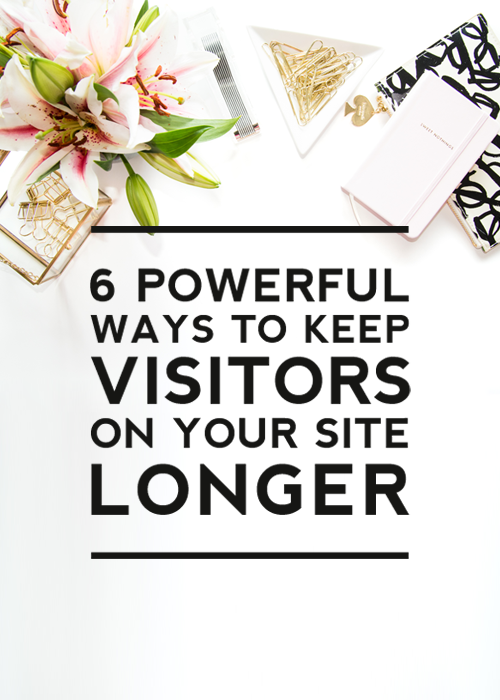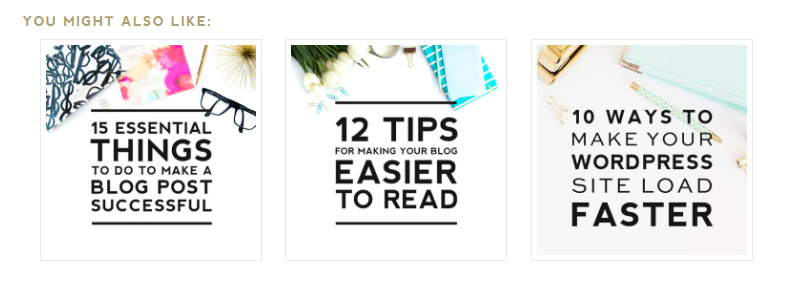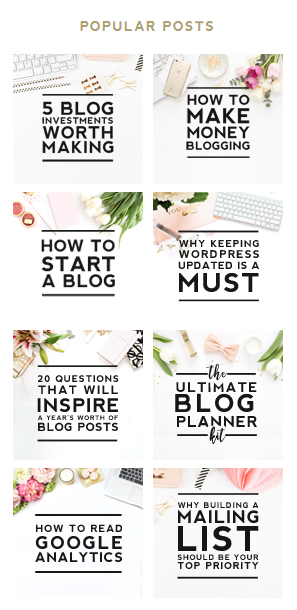
Do you know whatyour site's current bounce rateis?If not, log into your Google Analytics dashboard and take a look at it.Your bounce rate shows the percentage of visitors that landed on an individual page on your site and then bounced away without navigating to a second page.
You want your bounce rate percentage to be low.If yourbounce rate is higher than 50-60%then following the tips below will help you get it into a more desirable range.What's cool is that as you work to lower your bounce rate, you'll naturally see an increase in page views, average session duration, and conversions so it benefits your site all around.Below you'll find 6 powerful ways to keep visitors on your site longer and lower your bounce rate.
1.Make Your Content Easy to Read
When writing your blog posts, you want your content to be easy for your visitors to read.If your posts are unorganized and filled with long blocks of overwhelming text, you are going to lose visitors fast.Including plenty of whitespaces and using well-organized short paragraphs will increase the likelihood that your visitors will stick around to read your content all the way through.
To make your content easier to read, be sure to implement the following:
- Add subheadings to organize your content into easy-to-scan sections
- Shorten paragraphs so they include only two to five sentences
- Use horizontal line breaks to separate your content into sections
- Include bullets or numbered lists when possible
- Bold or italicize important phrases or keywords
- Include images and other visually appealing features to help draw your readers through the entire post
RELATED:12 Tips for Making Your Blog Easier to Read
2.Include related content at the bottom of posts
Offering links to related content at the bottom of each post is a great way to entice readers to stick around for more.
If a visitor is interested enough to finish reading through an entire post, they will most likely be interested in reading another post with similar content.Take advantage of interested readers.Make it easy for them to find out more about a topic by adding a related posts widget.Adding related posts to the bottom of your posts will help to hook visitors into your site and will in turn help to lower your bounce rate.

If you are on WordPress, installing a related posts plugin can increase your internal traffic up to 10%.This plugin will automatically select similar posts by default, but you can also manually select the posts you'd like to appear.
If you are not sure how to add related posts to your blogcontact us!We can add them for you!
3.Add popular posts to your sidebar
Similar to adding related posts to the bottom of each post, you can entice visitors to dive deeper into the content on your site by featuring popular posts on your sidebar.Your sidebar is prime real estate for showcasing the best contenton your site.Take advantage of this space by featuring the posts and pages you want people to read.Sidebar widgets appear on every page of your blog, so as visitors explore your blog, it increases the likelihood of them clicking over to one of your popular posts.

There are many great popular posts WordPress plugins that you can install.These plugins automatically calculate which of your posts have been visited the most and display those posts in the widget.If you don't want to use a plugin, you can also manually create your own list of posts you want to feature as we've done on our blog sidebar.
4.Take advantage of internal linking
Any time you create a new post, you should find natural ways to include links to related posts within your site.
It's also important to remember to edit old posts to include links to any new content you create that might be related.
Be sure when using internal links that you only include links that are related to the topic and that truly add value for your visitors.Taking advantage of internal linking will significantly increase your page views and will drive visitors deeper into your site.
RELATED:15 Essential Things Do to Make a Blog Post Successful
5.Speed up your site
There is nothing more annoying to a visitor than a slow-loading site.Having a website that takes longer than a few seconds to load will absolutely destroy your bounce rate because visitors will immediately hit the back button.You'll also be penalized by Google by having a slow-loading site, so do everything you can to get your site speed up.
A great tool for testing the site speed of your website can be found here:Google's PageSpeed Insights.We also highly recommend following the tips found in the related posts below.
RELATED:10 Ways to Make Your WordPress Site Load Faster&5 Ways to Make Your Blogger Blog Load Faster
6.Create easy navigation
Another key way to keep visitors on your site longer is to have a simple, well-organized navigation menu.This makes navigating around your site and finding information easy for your visitors and will keep them around longer.
Many websites have complicated menus with too many links and drop-downs which can be confusing for visitors.Keep your main menu simple and focused on the key pages you want your visitors to visit.Drop-down menus are helpful in offering more options under the main menu option, but try to limit the number of links in the drop-down portion to no more than ten, if possible.You can also effectively add navigation menus to your blog sidebar, but again, it's important to keep them simple.
RELATED:How to Add a Navigation Menu in WordPress
What other ways have you found to be successful in lowering your bounce rate?Let us know in the comments.






Great info here.Thanks for including the links to the wordpress plugins because that was really helpful!